The Largest Mosque in Dubai: Architectural and Cultural Insights
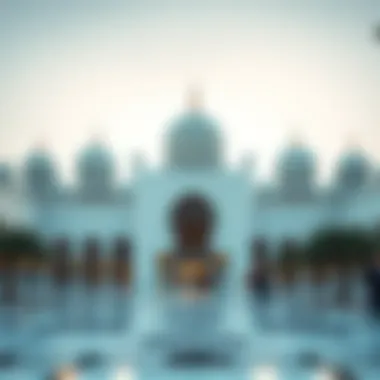
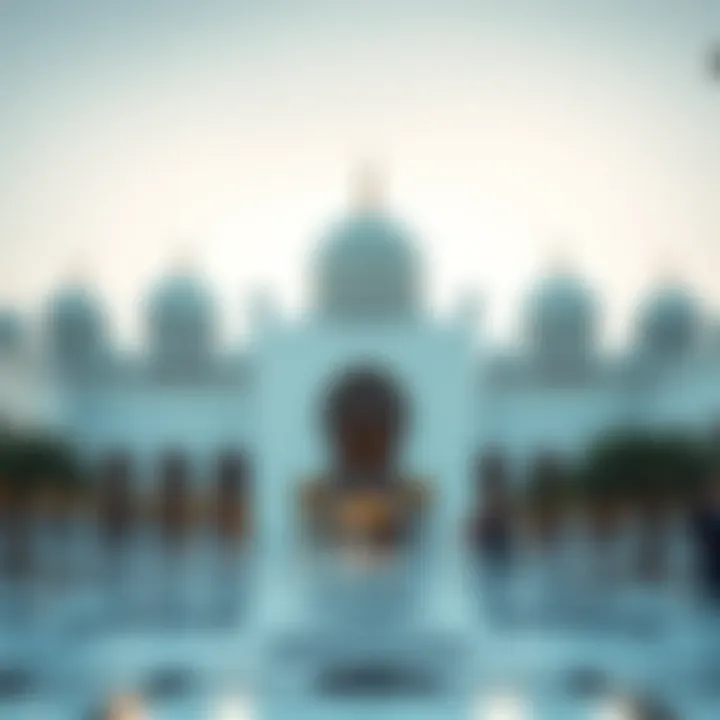
Intro
In the heart of Dubai, where modernity meets tradition, stands a magnificent structure that transcends mere architectural achievement. This grand mosque not only serves as a place of worship but also embodies the cultural essence of the UAE. As the sun casts its golden rays on its intricately designed domes and minarets, visitors are often left in awe. The mosque's sprawling courtyard welcomes thousands, each seeker drawn not just for faith but also for the unique experience that blends spirituality and tradition.
Its importance stretches beyond its breathtaking architecture. It acts as a social and cultural hub, bridging the gap between diverse communities in one of the world’s most cosmopolitan cities. In the pages to follow, we will dissect various elements surrounding this architectural icon. From the intricate artistry involved in its design to the role it plays in local cultures, this exploration aims to provide a profound understanding of the mosque in the context of Dubai’s ever-evolving landscape.
Historical Background of Dubai's Largest Mosque
Understanding the historical context of Dubai's largest mosque is essential for appreciating not only its architectural beauty but also its cultural significance. The mosque stands as a testament to the rapid evolution of Dubai from a modest fishing village to a global city. Its establishment marks a pivotal moment in the city’s history, reflecting the intertwined relationship between faith and urban development in the United Arab Emirates.
The Foundation of the Mosque
The foundation of the mosque is steeped in intent and vision. Construction began in the early 1990s, driven by a desire to create a spiritual sanctuary that could accommodate the growing population of Dubai. It was not just about building a place of worship; it was about laying down the roots of a cultural landmark that would define the skyline. Spanning across vast grounds, it invokes a sense of serenity amidst the bustling landscape surrounding it.
The visionaries behind the mosque aimed to create a space that would not only serve religious functions but also promote community cohesion. During its design phase, architects focused on drawing inspiration from traditional Islamic motifs while also incorporating modern elements to reflect Dubai’s unique identity as a bridge between east and west. It's fascinating to note that recent architectural styles were deemed necessary to ensure the mosque resonates with both locals and an international audience.
As for the materials, local artisans played a significant role in its construction, utilizing stone and marble sourced from various parts of the Arabian Peninsula to honor regional craftsmanship. This endeavor wasn’t merely about erecting a large structure; it was about embedding the spiritual and cultural essence of the community into every nook and cranny of the mosque.
Key Milestones in Construction
Construction of the mosque was marked by several key milestones that highlighted the commitment to quality and excellence. One notable phase was the completion of its towering minarets, designed to rise majestically into the Dubai sky. Standing tall, they not only serve as a call to prayer but also symbolize the harmony between tradition and modernity.
Additionally, the mosque faced its share of challenges—weather conditions and logistical hurdles often posed significant constraints. However, with sturdy planning and dedication from the construction teams, each difficulty was navigated effectively.
- 1994: Groundbreaking ceremony initiates the project, laying the soul of what is to come.
- 1996: Completion of the external structure, allowing for intricate design work to begin.
- 2000: Final touches are made, including the elaborate calligraphy and geometric patterns that adorn the interior.
Ultimately, upon its completion, the mosque was more than just a place of worship; it became a symbol of the unity and diversity that characterizes Dubai. It stands today as a remarkable fusion of cultural heritage and inspirational architecture—the very embodiment of the vibrant spirit of the Emirate.
Architectural Design and Features
The Architectural Design and Features section draws attention to the exquisite details and elements that make the mosque not just a place of worship, but a masterpiece of art and culture. This segment underscores how design speaks to both function and aesthetics, merging traditional Islamic values with modern engineering marvels. The mosque stands not only as a spiritual haven but also as a key cultural monument that reflects Dubai's ethos and vision for the future.
Exterior Design Elements
Materials Used
The materials selected for the mosque’s construction play a pivotal role in defining its identity. The main structure is primarily built using white marble, which is known for its durability and capacity to reflect light. This characteristic is significant because it enhances the mosque’s beauty during the day, radiating a soft glow that attracts visitors from far and wide. An added benefit is its thermal insulation properties, which help maintain a cooler interior, something quite desired in the searing heat of Dubai.
Another notable material is glass, encompassing large sections that integrate stained designs—a common element in Islamic architecture. This serves as both a visual treat and a practical feature, allowing natural light to illuminate the interior while simultaneously offering a sense of privacy for worshippers. However, this material does necessitate rigorous maintenance to prevent smudges and scratches, posing a slight disadvantage in the long run.
The careful selection of these materials exemplifies a balance of beauty and functionality, ensuring the mosque remains a lasting symbol of Islamic heritage in a rapidly modernizing city.
Color Palette
The color palette of the mosque is another standout feature, characterized by calming neutrals paired with vibrant accents. The dominant white and cream shades mirror the purity and serenity often associated with places of worship. This choice is not arbitrary; it conveys a message of peace and tranquility, which really resonates with the spiritual essence of the mosque.
Additionally, touches of gold and turquoise are interspersed throughout, adding rich contrasts and emphasizing key architectural details like domes and entrance arches. These colors are not only aesthetically appealing but also culturally significant, as they are commonly used in Islamic art to symbolize wealth, wisdom, and divinity. This unique feature further enchants visitors, captivating them with a sense of grandeur.
Interior Structure and Decor
Ceiling Artistry
Stepping inside, one is immediately drawn to the ceiling artistry, which is a breathtaking fusion of tradition and modern artistry. The ceilings are adorned with intricate geometric patterns and calligraphy, reflecting the deep-rooted Islamic traditions of beautiful scriptwork. This aspect of design contributes significantly to recognizing the mosque as a center of culture and spirituality.
Architects often employ carefully selected materials that join both wood and plaster to achieve this level of detail. The ornate chandeliers, made from hand-blown glass, combine functionality with artistic expression, casting delicate shadows and adding to the overall ambiance. Such artistic features invite contemplation, encouraging visitors to engage more profoundly with their surroundings.
Flooring Details
The flooring throughout the mosque is nothing short of spectacular. Imported marble tiles create an elegant flow that ties the entire space together. This choice is impressive not only for its luxurious appearance but also for its practical benefits; marble is easy to clean and maintain, a necessary consideration given the mosque's high foot traffic.
Local artisans often incorporate traditional designs into the flooring, creating a mosaic that tells stories through its patterns and colors. This aspect fosters a sense of connection between the visitors and the cultural heritage of the region, making the mosque feel lively and dynamic. However, it is vital to consider that high-gloss surfaces can sometimes be slippery, requiring caution as worshippers move about.
In summary, the architectural design and features of Dubai's largest mosque are integral to its role as both a spiritual and cultural hub. The interplay of materials, colors, and artistic details work harmoniously to create an inviting and reflective environment, showcasing a rich tapestry of history while embracing the future.
Capacity and Size Considerations
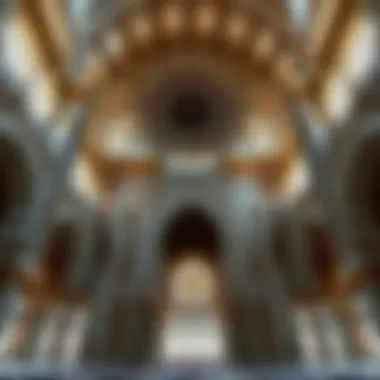
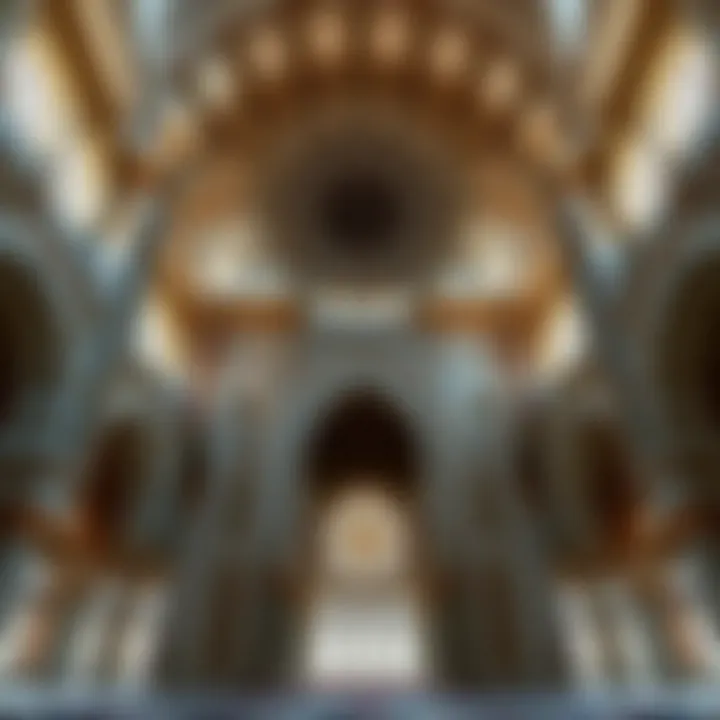
Understanding the capacity and size considerations of Dubai's largest mosque is crucial not only for its practical functioning but also for appreciating its significance within the cultural and spiritual fabric of the community. The sheer scale of the mosque plays a role in accommodating worshippers during daily prayers and special events, which often draw crowds that far exceed those at smaller places of worship.
Seating and Prayer Areas
Designed to hold thousands of worshippers, the seating arrangements within the mosque are thoughtfully curated to ensure a fluid flow of movement while providing optimal acoustics for sermons. The main prayer hall can accommodate over 10,000 individuals, making it one of the largest prayer spaces globally. This space isn’t just expansive; it's crafted to enhance the spiritual experience, incorporating soft carpets and significant natural light that floods through large arched windows, making the hall feel both inviting and solemn.
Furthermore, the accessibility of these areas reflects a broader commitment to inclusivity. There are dedicated sections for women, ensuring they have a space to worship comfortably while also being able to participate in congregational prayers without obstruction. This sensitive design choice acknowledges the diverse community in Dubai, catering to various demographics.
"A praying community is a united community; space significantly enhances that unity."
Comparison with Other Mosques
When one compares Dubai's mosque with others around the world, the distinction in capacity and design becomes glaring. For instance, the Great Mosque of Samarra in Iraq boasts a massive footprint, yet can only hold slightly more than the Dubai mosque given its unique architectural features that focus on height rather than floor space. Similarly, the Hassan II Mosque in Morocco is known for its grand minaret but also has restricted seating capacity, mainly due to its traditional structure.
In contrast, the largest mosque in Dubai strategically combines modern needs with traditional Arabic aesthetics, ensuring that visitors and worshippers experience a sense of grandeur alongside functionality. The size and planning mitigate overcrowding, especially during religious festivals like Ramadan and Eid, where attendance spikes dramatically.
In summary, the scale and design of the mosque not only enhance its role as a place of worship but also its position as a gathering hub in a bustling metropolis. This attention to size and capacity underscores its vital role in Dubai’s urban and social landscape, making it a landmark of faith and community engagement.
For more insights into the architectural features of significant mosques, reference Britannica and explore how different regions interpret mosque capacity.
Cultural and Spiritual Role
The cultural and spiritual role of Dubai's largest mosque transcends its stunning architectural presence. This sacred space serves as a vital hub for religious practices, fostering community ties while also enriching the cultural tapestry of Dubai. One cannot overlook how places of worship influence societal values and cohesion, which in turn fosters peace and amity in urban settings like Dubai.
A Gathering Place for Worship
Every day, the mosque welcomes worshippers from various walks of life, uniting them under the same roof for daily prayers. The sheer scale of its prayer halls speaks volumes about its ability to accommodate large congregations, especially during significant religious observances. During Friday prayers, for instance, the mosque becomes a hive of activity, with people arriving early to secure their spots, creating an atmosphere of collective devotion.
The mosque doesn’t just serve its regular attendees. Visitors from around the world come to witness this architectural marvel and participate in its spiritual offerings. Guided tours often include a brief overview of Islamic practices, showcasing the congregation's diversity while emphasizing unity in faith. It's fascinating how something as simple as a prayer can build bridges—fostering understanding and tolerance between cultures.
"In every prayer, there is a message of socialism, offering solace to the lonely while binding souls together in a shared belief."
Community Outreach and Education
Besides being a worship venue, the mosque plays a significant role in community outreach and education. Various programs are designed to involve local residents and international visitors alike, fostering a sense of togetherness. Educational initiatives, such as lectures and workshops on Islamic traditions and values, are regularly held, enhancing knowledge and appreciation for the faith.
The mosque’s outreach extends beyond spiritual education; it also includes humanitarian efforts. Initiatives to aid underprivileged communities reflect the Muslim ethos of charity, or Zakat, which is one of the Five Pillars of Islam. This highlights the mosque's commitment to bettering society.
Moreover, the mosque offers a welcoming environment for interfaith dialogues. When individuals from different backgrounds come together, it cultivates mutual respect and understanding, significantly influencing Dubai’s overall social fabric. The holistic approach of community service, education, and tolerance sets a standard for urban places of worship; emphasizing that a mosque is not just a religious building but a cornerstone of community life.
In summary, the cultural and spiritual significance of the largest mosque in Dubai is substantial. It stands as a beacon of faith, unity, and education, showcasing how places of worship can act as catalysts for community development and social harmony. By promoting understanding and compassion, the mosque contributes to a more harmonious Dubai.
Impact on Dubai's Tourism Sector
The largest mosque in Dubai stands as more than an architectural marvel; it plays a pivotal role in bolstering the local tourism sector. It not only attracts pilgrims and worshippers but also curious travelers keen on understanding the region's rich cultural fabric. The mosque's presence offers a unique opportunity for travelers to experience the confluence of spirituality and sophisticated urban design. It creates a bridge that connects visitors to the heart of Islamic traditions while spotlighting Dubai's rapid modernization.
Visitor Statistics and Trends
When it comes to visitor statistics, the mosque has seen a significant uptick in footfall since its inauguration. Estimates suggest that hundreds of thousands of tourists visit the mosque each year, contributing to the overall influx of visitors to Dubai. These figures reveal a trend: as Dubai enhances its identity as a global tourism hub, the mosque serves as a primary attraction, drawing a diverse crowd from different backgrounds.
- Peak Visiting Seasons: Typically, the highest numbers are recorded during Islamic holy months, particularly Ramadan. Visitors flock to the mosque for evening prayers and community iftars.
- Diverse Demographics: Notably, the demographic composition of visitors ranges widely. From affluent travelers seeking culture to families interested in education, each group finds something significant in the mosque's offerings.
What’s more, the mosque provides structured visitor data that helps local authorities and businesses plan better for peak times, ensuring the area can handle the influx without overwhelming facilities or infringing on the serene atmosphere intended for worship.
Integration into Cultural Tours
As Dubai continues to position itself on the world stage, the mosque’s integration into cultural tours marks a significant step in promoting intercultural understanding. Travel agencies often include it as a highlight in their itineraries, blending religious education with tourism. This integration comes with several advantages:
- Educational Value: Tourists are given guided access which often includes informative sessions about Islamic practices and architectural styles. This enables a respectful exploration of faith alongside awe-inspiring design.
- Cultural Exchange: Visitors who participate in these tours often express gratitude for the opportunity to learn and engage with local customs. It fosters respect and bridges cultural gaps, enriching not only tourists but also locals who interact with them.
- Economic Impact: The inclusion of the mosque in cultural tours promotes engagement with surrounding businesses like cafes, shops, and art galleries, allowing economic benefits to ripple through the community.
In summary, the mosque’s role extends beyond a mere place of worship; it is an active participant in Dubai's tourism dialogue. By fostering understanding and appreciation for Islamic culture, it contributes significantly to the city's appeal as a tourist destination.
"Tourists nowadays seek more than luxury resorts or shopping sprees; they crave authentic cultural experiences that inform and engage them in the fabric of a place. The largest mosque in Dubai is a testament to this evolution in tourism."
Visitor Experience
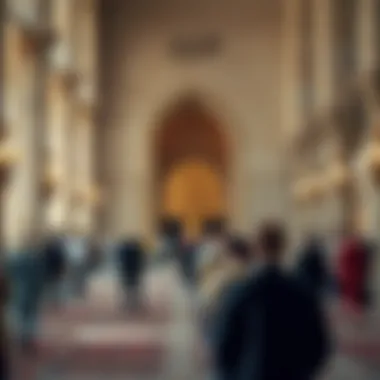
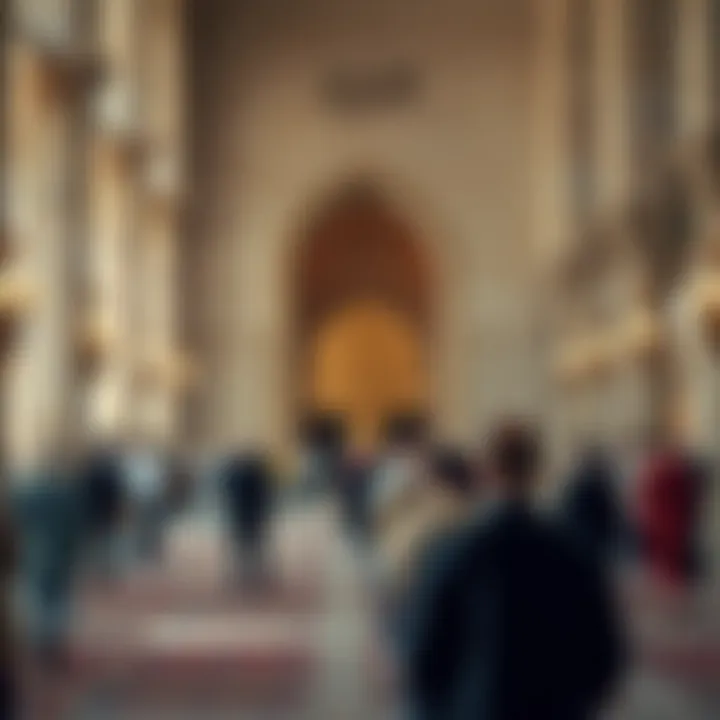
Understanding the visitor experience at Dubai's largest mosque is essential for appreciating its role both as a landmark and as a spiritual haven. The mosque attracts countless tourists, pilgrims, and local community members, making it vital for the mosque authorities to ensure everyone has a fulfilling and respectful experience. Offering guided tours, clear protocols, and cultural sensitivity are just a few elements that contribute to a positive experience.
Guided Tours and Protocols
Guided tours play a pivotal role in providing visitors with insights into the mosque's architecture, history, and the culture it embodies. These tours often include the following features:
- Expert-Led Tours: Knowledgeable guides share stories and anecdotes, enriching the experience beyond mere observation.
- Structured Itineraries: Groups follow a well-organized route, ensuring that all important aspects are covered without leaving anyone feeling lost or rushed.
- Language Options: Tours are usually available in multiple languages, catering to the diverse backgrounds of the visitors.
Moreover, clear protocols are established to ensure the decorum of the mosque is maintained.
- Dress Code: Visitors are required to adhere to a modest dress code, which is typically communicated during the booking process.
- Photography Restrictions: Areas might have strict rules regarding photography to maintain the sanctity of the space.
- Guidelines for Behavior: Guests receive a briefing on expected behavior, such as maintaining silence during prayers and respecting worshippers.
Establishing these elements enhances not only the learning experience but also the overall respect for the mosque as a holy site.
Cultural Sensitivity for Tourists
Awareness of cultural sensitivity is critical for visitors at the mosque. As a reflection of Islamic teachings and Emirati culture, tourists must approach their experience with respect and openness. Here are some vital considerations:
- Understanding Religious Practices: Visitors should familiarize themselves with the mosque's practices, such as the five daily prayers and communal gatherings, which can enhance their engagement.
- Respecting Local Traditions: Small gestures like greeting locals or thanking the guide in Arabic can create a positive interaction and demonstrate appreciation for the culture.
- Mindful Observation: Tourists are encouraged to observe ceremonial activities silently, allowing worshippers to carry on without interruption.
"Cultural sensitivity is not just about adhering to guidelines; it’s about embracing the essence of what makes the mosque a cherished space in the heart of Dubai."
Ultimately, a mindful approach and an eagerness to learn can transform a simple visit into a profound experience. Visitors often leave with a deeper appreciation of Dubai's cultural diversities, paving the way for mutual respect among people of varying backgrounds.
Religious Practices and Events
The vibrancy of a mosque transcends its architectural splendor; it lies at the very heart of community and spiritual life. The largest mosque in Dubai serves as a beacon of faith, uniquely intertwining religious practices and events into the urban fabric. Understanding these elements provides insight into the mosque's significance not only as a place of worship but also as a societal cornerstone that fosters unity, education, and cultural understanding among diverse populations.
Daily Prayers and Services
At the core of the mosque's operations are the daily prayers, which are central to Islamic worship. Every day, five prayers punctuate the rhythm of life for Muslims, and the mosque serves as the main gathering point for this purpose. The call to prayer, or adhan, resonates through the area, inviting both faithful and curious onlookers to partake in an experience that combines spirituality and communal solidarity.
During these gatherings, worshippers not only engage in prayers but also reinforce a sense of belonging. Observers marvel at the seamless flow of traffic between the mosque's spacious main prayer hall and its surrounding courtyards, illustrating an important aspect of communal worship. Every corner of the mosque is designed to accommodate visitors and worshippers alike, ensuring deep-rooted engagement with the faith.
Furthermore, the role played by the mosque extends beyond just prayers. Educational sessions often accompany these gatherings, where knowledgeable scholars impart teachings that clarify Islamic principles and ethical guidelines. These teachings include discussions about personal development, social justice, and the importance of connecting with the community.
"In every prayer, there is a reflection of unity. Despite our differences, under one dome, we stand together in faith."
Special Religious Observances
Special religious observances at the mosque reflect the rich tapestry of Islamic traditions. Events such as Eid al-Fitr and Eid al-Adha draw particularly large crowds, transforming the mosque into a hub of joyous celebration. These significant days are both communal and spiritual milestones, offering opportunities for deeper connection with the divine and fellow Muslims.
During Eid al-Fitr, the conclusion of Ramadan, the mosque transforms into a vibrant scene of festivity. Families gather early, dressed in their best attire, to celebrate the conclusion of fasting with special prayers and community feasting. The atmosphere is electric, as the shared spirit of gratitude fills the air. Here, the mosque amplifies its role beyond that of a religious site, becoming a place of vibrant social interaction.
Additionally, during Eid al-Adha, which commemorates the willingness of Ibrahim to sacrifice his son, the mosque plays a critical role in the rituals of sacrifice and distribution of meat to the needy, echoing themes of charity and community support.
This mosque also holds educational seminars and talks during these special events, helping the community delve into the significance of the celebrations and their religious importance. Attendees leave not just with a sense of festivity but with enriched knowledge about their faith and its broader implications.
Sustainability and Maintenance
Sustainability and maintenance are pivotal aspects to consider when it comes to the largest mosque in Dubai. These elements are crucial not only for preserving the mosque’s grandeur but also for aligning with the global movement towards eco-friendliness. The mosque stands as a symbol of faith and devotion, but it also represents modern architectural practices that prioritize environmental stewardship. Given the rapidly changing climate and increasing urbanization, maintaining such a monumental structure while ensuring its sustainability is a challenging yet essential endeavor.
Eco-Friendly Architectures
The mosque's design exemplifies eco-friendly architectures, integrating several sustainable practices that minimize its environmental footprint. The use of energy-efficient systems is notable, particularly LED lighting which illuminates the vast prayer halls with minimal power consumption.
In addition, the structure employs water conservation techniques through rainwater harvesting systems and advanced irrigation for its beautiful surrounding gardens. Such features not only sustain the mosque but also educate visitors on the significance of environmental consciousness in religious practices.
- Solar panels are strategically placed, harnessing the abundant sunlight typical of Dubai. This renewable energy source helps power various facilities and supports an eco-friendly approach to operations.
- The landscaping showcases native flora, which requires less water and maintenance than exotic plants, further optimizing the composition of the outdoor environment.
Ongoing Maintenance Challenges
While these eco-friendly implementations are commendable, they also come with a unique set of maintenance challenges. Keeping such a large structure in pristine condition demands regular upkeep. For example, the heavy foot traffic in the prayer halls necessitates continuous attention to flooring and decor.
Adverse weather patterns in the UAE, including sandstorms, pose another hurdle. The mosque must employ specialized cleaning techniques and materials that withstand such conditions without compromising its aesthetic appeal.
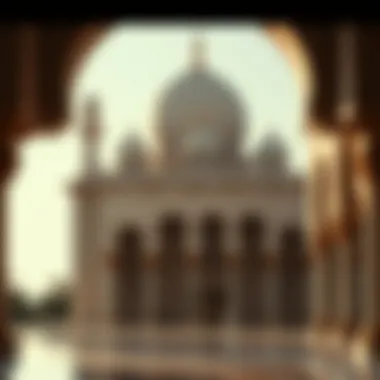
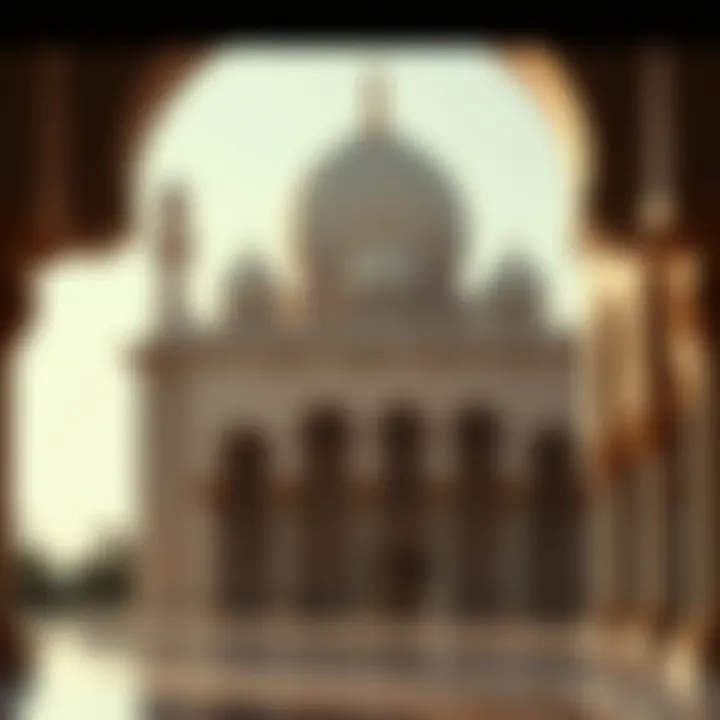
Moreover, the focus on sustainability requires that the maintenance not only preserves the existing beauty of the mosque but also upholds its environmental commitments.
- Routine audits of energy systems ensure that they operate at optimal efficiency, as any lapse could have a wider impact on sustainability efforts.
- Finding skilled workers who understand both traditional preservation methods and modern sustainable technologies can be difficult, influencing the costs and timelines for maintenance projects.
"In a city like Dubai, where tradition meets modernity, the challenge lies in maintaining the delicate balance between preserving our heritage and adopting sustainable practices."
Investors and real estate developers eyeing the area should consider these aspects seriously, as they impact not just the mosque but the surrounding developments as well.
Role in the Urban Development of Dubai
The architectural marvel that is Dubai's largest mosque stands not just as a place of worship but also as a hallmark of urban transformation in the city. Over the last few decades, Dubai has morphed from a humble trading post into a global metropolis, with architectural feats that attract international attention. The mosque plays a pivotal role within this narrative, providing both cultural anchor and visual grandeur that shapes the city’s skyline.
Symbol of Modern Islamic Architecture
This mosque is more than bricks and mortar; it represents a fusion of tradition and innovation. The designers took cues from historic Islamic architecture, integrating elements that remind us of centuries past while also pushing the envelope of modern aesthetics. Its soaring minarets and intricate calligraphy, for example, are modern interpretations of classic themes. Such design not only enriches the skyline but also invites admiration from architects and casual observers alike.
The use of state-of-the-art materials has set a precedent in civic projects. The mosque’s facade, adorned in shimmering marble and adorned with hand-crafted mosaics, showcases the latest advancements in construction technology while ensuring sustainability practices remain in focus. This balance between ambient beauty and modern efficiency presents a unique opportunity for investors and developers in urban planning, reflecting an importance that cannot be understated.
Influence on Property Values Nearby
Beyond aesthetics, the mosque has noticeable effects on the local property market. Properties within a close radius often see a surge in demand, thanks in part to the mosque's stature and the community activities it fosters. When potential buyers or renters consider a location, the mosque’s proximity frequently makes a compelling argument for investment. This echoes broader trends in real estate where spiritual and cultural hubs enhance nearby property values.
Key aspects to consider include:
- Cultural Appeal: Proximity to the mosque makes properties more attractive, especially among those who value cultural depth.
- Increased Foot Traffic: With regular visitors and special events, the surrounding area benefits from a steady influx of people, enhancing local commerce.
- Community Development: New residential or commercial projects that spring up near the mosque align with the cultural narrative, which often appeals to investors looking for value-adding opportunities.
In essence, the role of the mosque extends far beyond its spiritual significance; it serves as a catalyst for growth, architectural innovation, and real estate dynamics, weaving itself into the intricate fabric of Dubai’s ongoing urban evolution.
"With each brick laid, a new chapter in Dubai's story unfolds, intertwining faith, culture, and economic promise."
Gardens and Surrounding Areas
The open spaces surrounding Dubai's largest mosque play a vital role in enhancing the overall experience for its visitors. Often seen merely as embellishments, these gardens and surrounding areas intertwine with the mosque's identity. They offer visitors a chance to engage with the environment in ways that encourage reflection and tranquility. By providing a serene backdrop, these features notably contribute to the mosque’s cultural significance.
Landscaping Features
The landscaping surrounding the mosque is meticulously designed, reflecting both aesthetics and cultural symbolism. Lush greenery, pathways interspersed with flowering plants, and carefully placed lighting turn a visit into an immersive experience.
- Sustainability: Many plants used in the landscape are native to the UAE, showcasing a respect for the local ecology. Drought-resistant species ensure a resilient garden while minimizing water usage.
- Cultural symbols: The layout sometimes incorporates patterns found in Islamic art. This might include geometric designs or the use of water features that recall traditional courtyard gardens.
- Interactive spaces: Benches and shaded areas allow visitors to pause and appreciate their surroundings, creating spots for casual gatherings or quiet contemplation.
Public Spaces for Reflection
The mosque's gardens also serve as public spaces designed for reflection and meditation. Unlike the bustling streets of Dubai, these serene locales are optimized for peace and introspection.
- Prayer gardens: Certain areas are specially designated for individuals seeking solitude. The gentle sound of water features combined with the sights of nature invite a spirit of calm.
- Community gatherings: The gardens also host events that nurture community ties, such as educational programs and cultural celebrations. They make the mosque a lively hub for spiritual and social engagement.
- Accessibility: These areas are designed to be accessible to all, promoting inclusivity and ensuring that everyone can benefit from the peace this space provides.
"Gardens and surrounding areas are not simply decorations; they are integral to the mosque’s role as a communal and spiritual space, fostering an environment conducive to reflection and connection."
In summary, the gardens and areas surrounding Dubai's largest mosque are more than just mere aesthetics. They enhance the visitor experience, foster community engagement, and provide spaces meant for reflection, ensuring that the mosque isn't just a religious site but a holistic center for culture and tranquility.
Finale
The conclusion of this exploration into Dubai's largest mosque plays a pivotal role in understanding both its architectural significance and cultural importance. Summarizing the major themes discussed throughout the article brings to light not only the intricate details of the mosque's design but also its profound impact on the community and tourism in Dubai. As a crescendo to the narrative, this section helps to tie together the various threads—be it the mosque’s stunning structural elements, its function as a spiritual sanctuary, or its role as a focal point for cultural gatherings.
Summarizing Significance
In summarizing the mosque's significance, one must note that it stands as a beacon of modern Islamic architecture, attracting visitors from all corners of the globe. It embodies the essence of Dubai's melding of tradition and contemporary charm. Not just a place of worship, the mosque serves as a center for dialogue, education, and cultural exchange. It reflects the values and goals of a rapidly evolving society, fostering a deeper understanding among diverse populations.
Key components of its significance include:
- Aesthetic Appeal: The stunning design of the mosque blends traditional Islamic motifs with cutting-edge techniques.
- Cultural Hub: Beyond being a religious destination, it hosts events that bring together various cultural backgrounds, showcasing the city’s diversity.
- Tourism and Economics: As a landmark, it contributes significantly to Dubai’s allure as a tourist hotspot, impacting local economy positively.
This religious site is not just a structure; it symbolizes the collective identity of a community, reinforcing shared values and beliefs.
Future Prospects for the Mosque
Looking ahead, the future of the mosque seems both bright and promising, indicating a sustained commitment to its role in the community and its architectural elegance. As Dubai continues to grow, the mosque will likely adapt and evolve to meet the needs of its visitors and worshipers.
Several prospective developments to consider may include:
- Enhanced Visitor Experience: Innovations in visitor engagement, such as virtual reality tours, could further bridge the gap between the cultural past and technological future.
- Sustainable Upgrades: Continued focus on sustainable practices in maintenance and operations can ensure that the mosque does its part in the fight against climate change while preserving its grandeur for future generations.
- Cultural Programs: Expanding educational initiatives about Islam and Islamic culture can reinforce the mosque's role as a cultural ambassador, inviting dialogue and understanding in an increasingly polarized world.
Ultimately, the mosque will continue to adapt, embracing change while holding steadfast to its roots. This balance of tradition and innovation will ensure that it remains a pivotal part of Dubai's urban identity and a cherished landmark for years to come.



